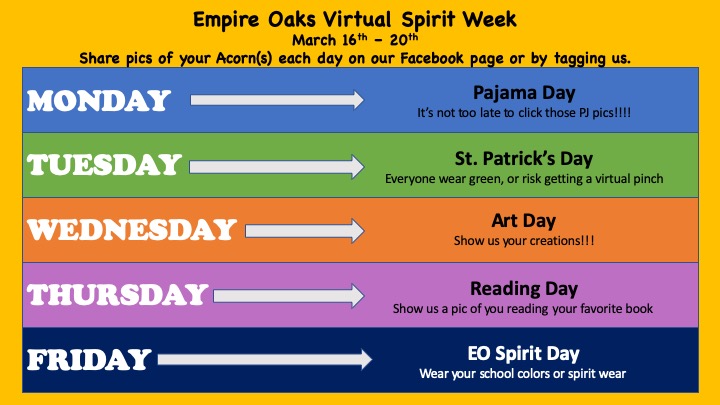Fellow educators—well, we’ve certainly had a fun couple of weeks, right? It’s an understatement to say that the coronavirus (COVD19) has rocked our worlds.
 While you’re still in the midst of determining how your schools can continue to deliver education to your students, staying tuned for more emerging details (including how long your schools will need to remain closed, whether standardized testing will proceed, etc.), and feeding your most needy students, there is something that will remain constant: your relationships with your students.
While you’re still in the midst of determining how your schools can continue to deliver education to your students, staying tuned for more emerging details (including how long your schools will need to remain closed, whether standardized testing will proceed, etc.), and feeding your most needy students, there is something that will remain constant: your relationships with your students.
First, while parents are in the process of learning how to home school their children, as educators, you are likely grappling with a number of emotions, and the first is probably missing your students. While scheduled school breaks offer a needed reprieve from work duties, and leave you feeling energized when you return to the classroom, this unexpected (and undetermined) break has likely filled you with some anxiety, possibly some depression, mourning, and has also taken away a huge part of your daily purpose. All of these feelings can sap creativity and drive, and my hope is that the ideas I’m offering in this post will help inspire you and bring a little spring back in your step. Whether you’re a school principal or a teacher, your relationships with your students is what is at the core of why they succeed, why they want to be lifelong learners, and why you’re an amazing educator.
How do you keep relationships with students going when schools are closed?
I’m going to spend the next few weeks curating some of the best ideas that will likely emerge across the nation, but I wanted to share some ideas with you now, in case it may help with your current efforts. And, because your parents and students have varying access to the internet and computers, I’m offering both high and low tech approaches.
Something to note: A lot of parents have smart phones…they may not have computers or wifi, but in a survey that I did of a high poverty district in California, 95% of the parents had smart phones. Based on comparing notes with other school communication colleagues, this number is consistent across the state. So, at the very least, most parents have some kind of access to online technology, but it’s also important to keep in mind the other 5% who do not.
Keep following this page for updates, and check in on my social media pages for more ideas.
Low-tech ways to stay connected with your students
- Call them! A personal telephone call is a great way for your students to get a personal touch from you, and for them to hear your voice. It’s also a great way to check in with parents to find out if they have access to computers and wifi to determine ongoing tech needs. If you’re comfortable, ask your students to give you a call, if they need to talk. You may have some students who are in home or life situations who found school to be a necessary escape, and may need to have that check-in with you. Also use this as an opportunity to remind students and parents about community and district services that are available to provide food, health and other services.
- Write them a letter: As long as mail delivery continues, writing your students a letter will be a wonderful, unexpected surprise in their mail box. Check in with your school site or district regarding mailing the letters or getting reimbursed for your personal costs.
- Email: A weekly/biweekly email to your students and their parents is a great way to stay connected. Provide them ideas for continued learning and share some fun things you’ve been doing at home.
Hi-tech ways to stay connected with your students
- Videos: Consider using video to do the things with students that involve you at the front of the classroom—for TK and kindergarteners, this could be your welcome time (weather, counting, letter of the day, etc.) and reading a story, for lower grades, this could be providing directions on art work/a project, reading a story, explaining math concepts, etc. For middle and high school teachers, this could be some of your facilitated learning approaches and explanation of concepts. PE teachers, this is where you’ll rock: do a virtual dance party, show students how you’re staying active while school is closed, demonstrate the proper way to lift weights…the list goes on.
- Video chat: For group video conferencing, Skype, Hangouts, Hangouts Meets and Zoom are good free options. Consider scheduling smaller group chats to keep the chat environment manageable. Ask your students to send you pictures, videos so that you can share them out with each group. Here is a list of a number of tech tools that will help with presentations, collaborations and chats: https://techagainstcoronavirus.com/
Community-building
- Keep traditions going: Spirit weeks can go home with fun approaches that also engage social media—check out this example from Empire Oaks Elementary School’s PTA:
- Celebrations: Do you celebrate your students at school? Don’t stop celebrating them because they aren’t there. Here are some ideas:
- Provide parents some ideas of what they can do to celebrate their children-as-students at home. Citizenship, helping others, and other character traits should continue to be celebrated, and in the trenches of these transitions, parents may need a helpful reminder that their children love being recognized for what they’re doing well.
- Ask parents to tell you if their child is excelling at something so that you can verbally recognize them when you send a video or do a group chat. For older students, ask them what they’ve been doing well so they can celebrate together.
- Taking a page from the summer reading programs, have your students/parents submit a reading log and recognize students who have read for the most number of minutes. If you have permission to post this online, put together a social media post recognizing your top readers (Canva is an excellent, easy to use, and free program for this). You could do the same with math and other subjects.
- Class Stuffed Animal (good for TK, kinder and lower grades): Well, since the class stuffed animal isn’t going home, he or she is probably feeling a little lonely! Ask your students (with mom and dad’s help) to send pictures and videos of themselves with their stuffed animals, or schedule a stuffed animal video chat with a fun story.
- A note about high school traditions: I’m not ignoring them, as there are so many incredible high school traditions focused on togetherness—proms, grad walks, senior breakfasts—and your students, especially seniors, are likely feeling deep disappointment about the possibility (or reality) that those events will be rescheduled or even cancelled. If you’re already cooking up ideas on how your school will be approaching this, please provide those ideas in the comment box, and I’ll also add those ideas to this post.
Note to School Districts: Don’t stop celebrating your schools and staff because of school closures. Ask teachers, staff to send you pictures, videos of what they’re doing and curate those examples into stories about how your district is continuing to educate and keep your school communities connected.
These are just a few ideas, and I’ll continue to collect more.
Please leave some of your favorite ideas in the comment box or on my social media, and I’ll add them to this post!

